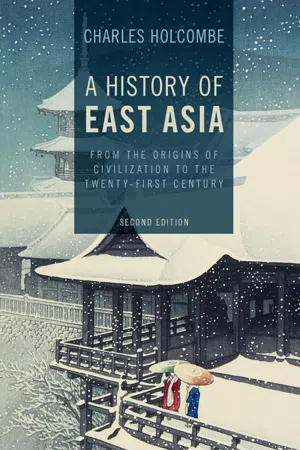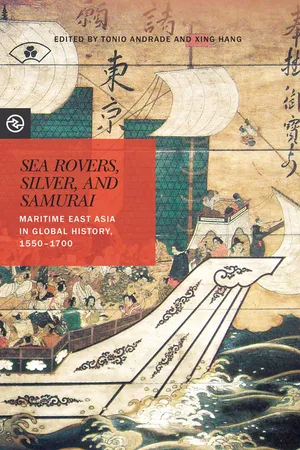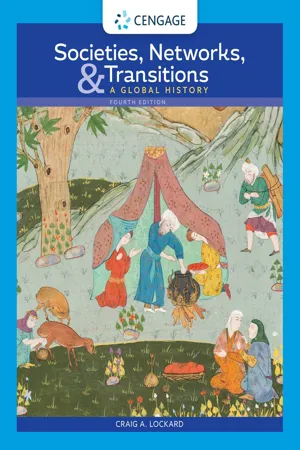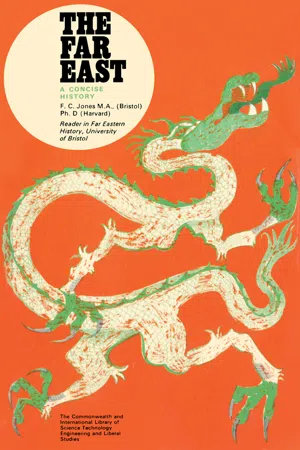History
Medieval East Asia
Medieval East Asia refers to the historical period from roughly the 5th century to the 15th century in the eastern part of the Asian continent, encompassing regions such as China, Korea, and Japan. During this time, East Asia experienced significant cultural, technological, and political developments, including the rise of influential dynasties, the spread of Buddhism, and the flourishing of art and literature.
Written by Perlego with AI-assistance
Related key terms
1 of 5
5 Key excerpts on "Medieval East Asia"
- eBook - PDF
A History of East Asia
From the Origins of Civilization to the Twenty-First Century
- Charles Holcombe(Author)
- 2017(Publication Date)
- Cambridge University Press(Publisher)
6 Early Modern East Asia (Sixteenth–Eighteenth Centuries) Late Ming ([1368–] Sixteenth Century–1644) and Qing (1644–Eighteenth Century [–1912]) Dynasty China Late Ming Consumer Culture Even to suggest that East Asia had an early modern period remains somewhat controversial. The word modern comes from Late Latin, and the entire concept of modernity emerged originally in the specific context of European history. 1 There is, furthermore, no denying the driving role that was played by western Europe (and its overseas colonial offspring, including the United States) in giving shape to what we think of as the modern world. With regard to non-Western civilizations, there is still a tendency to prefer imagining them as societies that had always been changelessly traditional, from some primordial beginning until relatively recently, when the process of modernization (often assumed to be synonymous with West- ernization) finally started as a direct consequence of contact with the modern West. East Asian history is still commonly divided into only two major parts, premodern and modern, with the point of transition placed somewhere in the nineteenth century. Yet, paradoxically, the use of paper money, printing, gunpowder, urban- ization, market-based commercialization, complex bureaucratic administration, and a relatively fluid meritocratic sociopolitical order based on the examination system all make Song Dynasty China (960–1279) seem curiously modern already a thousand years ago! The idea of a changelessly static East Asia, at any rate, is a fantasy, sustained only by lack of historical knowledge. If long-term historical change is acknowledged for the non-Western world, another common approach has been to assume that it must naturally have followed the familiar three-stage European historical sequence of ancient, medieval, and modern. This sequence is often presumed to be universal, and applied rather mechanically to East Asian history. - eBook - PDF
Offshore Asia
Maritime Interactions in Eastern Asia before Steamships
- Fujita Kayoko, Momoki Shiro, Anthony Reid(Authors)
- 2013(Publication Date)
- ISEAS Publishing(Publisher)
16 According to Ishii and Sakurai 17 the “medieval” history of Southeast Asia started in the 10th century following the development of maritime trade mainly caused by fundamental changes in Chinese state and society during the “Tang-Song Transition”. The “13th-century crisis” of Cœdès can be regarded as the final collapse of ancient states which could not enhance trade. Sakurai found a fundamental change in the fact that “historical circles” (a concept like mandala) up to the 8th century left few historical memories to later ones. 18 The concept of the Tang-Song Transition was first proposed by Naitō Konan (1866–1934), the first professor of Chinese History at Kyoto University. Based on this concept, a famous periodization dispute occurred after World War II between the “ Rekiken ” Marxist school (Rekishigaku Kenkyūkai, a leading group of the “Post-War Historiography”), which thought a feudal society was established after the transition, and the Kyoto School, which regarded Chinese society after the Song as an “early modern” one. 19 In Northeast Asia, recent academic criticism has been trying to deconstruct deeply rooted linear nation-state-oriented historiography in every country in the region. This criticism often requires a change in the standards of periodization, and sometimes a change in periodization itself. 20 In the case of Japan, the period from the 9th or 10th to the 14th centuries is usually treated as the end of the ancient period and the beginning of Periodization of Southeast Asian History 19 the Middle Ages. 21 The ancient state and society of Japan which had been established in the 8th century began to change after the Heian (Kyoto) Capital was established in 794. - eBook - PDF
Sea Rovers, Silver, and Samurai
Maritime East Asia in Global History, 1550–1700
- Tonio Andrade, Xing Hang, Anand A. Yang, Kieko Matteson(Authors)
- 2016(Publication Date)
- University of Hawaii Press(Publisher)
1 I NTRODUCTION The East Asian Maritime Realm in Global History, 1500–1700 Tonio Andrade and Xing Hang M aritime East Asia is a contentious place. Traversed by some of the world’s busiest shipping lanes and endowed with rich fisheries and huge deposits of oil, it is a confusing morass of contested sovereignties and geopolitical rivalries. Few maritime regions today are subject to such dissonant and dangerous claims and counterclaims, with Filipino, Japanese, Chinese, Taiwanese, Vietnamese, Malaysian, and Bru-neian pirates, statesmen, soldiers, and civilians disputing isolated—and of-ten uninhabited—atolls. An East Asian war is more likely to erupt over the Diaoyu or Spratly Islands than over any land borders. This unsettled situation is a legacy of the peculiar history of East Asia’s maritime realm. Stretching from the Strait of Malacca to the Sea of Japan and centered upon the East and South China Seas, the seaways of East Asia have been a core region of international trade for centuries. However, dur-ing the period from 1500 to 1700, the velocity and scale of that commerce increased dramatically. The lucrative export of massive quantities of silver from Japan for Chinese silk and Southeast Asian tropical goods wove the region together into a coherent zone of exchange. Besides the Chinese junks, the Japanese red-seal ( shuin ) vessels, and the Southeast Asian jongs that be-came a staple of its ports and sea lanes, Indian dhows, Spanish galleons, and Dutch and English men-of-war increasingly connected maritime East Asia to a thriving global economic system that also comprised the Indian Ocean, Europe, and the Americas. Maritime East Asia shares much in common with other maritime “worlds”—the Mediterranean World, the Atlantic World, and the Indian Ocean World. These zones of trade and communication have received far more scholarly attention, and in fact, historians of East Asia have tried to understand East Asian waterways in terms of those other oceans. - eBook - PDF
Societies, Networks, and Transitions
A Global History
- Craig Lockard(Author)
- 2020(Publication Date)
- Cengage Learning EMEA(Publisher)
Due to electronic rights, some third party content may be suppressed from the eBook and/or eChapter(s). Editorial review has deemed that any suppressed content does not materially affect the overall learning experience. Cengage Learning reserves the right to remove additional content at any time if subsequent rights restrictions require it. 266 CHAPTER 11 East Asian Traditions, Transformations, and Eurasian Encounters, 600–1500 Canal linking the Yellow and Yangzi River Basins allowed mass movement of goods between north and south. To support this commerce, China developed the world’s first fully monetized economy, putting paper money and silver coins into wide use. Song China also enjoyed the world’s most advanced farming. Farmers doubled the rice crop and vastly increased the growing and marketing of sugar, once a minor crop. Meanwhile, foreign trade flourished from maritime networks connecting China to the rest of Afro-Eurasia. Some historians describe the South China Sea in Song times and since as a kind of Asian ver- sion of the Mediterranean Sea, traversed by trading ships from China, Southeast Asia, and the Middle East carrying goods and people. Chinese were now as likely to import horses by sea from Arabia and Central Asia via India as along the old Silk Road network. Chinese merchants regularly visited and even settled in Southeast Asia and Japan, and a few Chinese traded as far west as India. Chinese industrial and food products found mar- kets in Persia, East Africa, and Egypt. Thousands of foreigners found their way to China, including Indonesian, Arab, Indian, Persian, and even East African merchants, and lived in the cosmopolitan southern seaports of Guangzhou (Canton) and Quanzhou (Zayton). Both cities contained numerous mosques and Hindu temples. China was hence linked to a hemispheric- wide trading network. - eBook - PDF
The Far East
A Concise History
- F. C. Jones, G. M. D. Howat(Authors)
- 2014(Publication Date)
- Pergamon(Publisher)
Nestorian Christianity, Mohammedanism and Judaism all entered China during this period and these were considerable Arab and Jewish communi-ties in Canton, which rose to eminence as a seaport, as well as in Ch'ang An. Buddhism continued to flourish and its influence was especially predominant in sculpture and in painting. The T'ang was perhaps the greatest age of Chinese poetry. It also saw the invention of printing by means of wooden blocks, which increased the circulation of religious and secular literature. The later T'ang period was marked by a Confucianist revival, as a reaction 28 THE FAR EAST IN ANCIENT AND MEDIAEVAL TIMES against undue foreign influences. This resulted in a renewed per-secution of the Buddhists and the destruction of many monaster-ies. Chinese Buddhism itself became increasingly influenced by Confucianist and Taoist ideas, especially because it was in decay in India. The three main Buddhist sects were the Ch'an (in Japa-nese Zen), or contemplative and intuitive school, the T'ien T'ai, which laid more stress on scripture and ritual, and the popular Pure Land school, whose central theme was the worship of Amida Buddha, through whom came salvation. The various foreign influences which came in during the T'ang epoch resulted in new developments in astronomy, map-making, medicine, agriculture and music. Yet all these cultural and scientific achievements remained very largely the monopoly of the elite ; for the mass of the people life was onerous and uncertain, especially during the rebellions and disorders of the ninth and tenth centuries. THE SUNG EPOCH, 960-1279 The collapse of the T'ang empire facilitated the advance into north-eastern China of the K'itan, a people whose home territory was around the Liao River, in central Manchuria. In 938 their king assumed the title of emperor and founded the Liao dynasty with its capital at Yenching. Marco Polo's name for north China — Cathay — is a corruption of K'itan.
Index pages curate the most relevant extracts from our library of academic textbooks. They’ve been created using an in-house natural language model (NLM), each adding context and meaning to key research topics.




